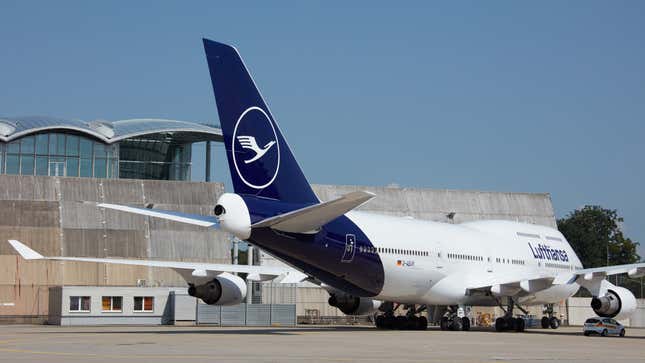Whereas automakers are comfortable to swap their lineups to hybrid and electrical energy to chop international emissions, it’s a lot tougher for airways to slash their carbon footprints. Electrical planes could also be within the works and sustainable fuels are being trialed, however three European airways are testing a brand new approach to minimize their gasoline use: faux shark pores and skin fitted to their planes.
German service Lufthansa and its subsidiaries have been evaluating a brand new materials on the outside of its planes to assist minimize carbon emissions from air journey. The trial noticed it match 17 plane with a cloth that mimics the tough floor of shark pores and skin, catchily named AeroSHARK. The coating reduces drag on the planes that means that they will fly extra effectively, stories Futurism.
Thus far, the fabric has been fitted to Lufthansa and Swiss Airways planes, which have logged greater than 100,000 flight hours. Over that point, they’ve minimize greater than 6,000 tons of gasoline and minimize greater than 19,000 tons of carbon emissions from their flights. Because of the constructive outcomes, AeroSHARK is now being added to 4 Austrian Airways plane, as Futurism stories:
That being mentioned, Lufthsansa’s formulation already appears to supply tangible advantages. 4 Boeing passenger planes shall be lined with about 9,000 sq. toes of AeroSHARK riblets, which is anticipated to scale back drag by about one %. That won’t sound like quite a bit, however even that tiny margin will make a big distinction over many flights.
The airline claims that over 4 years, the plane will every save about 8,300 metric tons value of CO2 emissions — the equal of 46 flights from Vienna to New York.
It’d sound conter-intutitve to tough up the floor of a airplane to make it minimize by way of the air smoother, but it surely’s the identical type of tech that helped Olympic swimmers break numerous world information with the tremendous fits developed for the 2012 video games.

The fabric that’s being fitted to Lufthansa’s planes measures simply 50 microns, which is thinner than a human hair. It’s lined in minuscule riblets, which scale back the friction between the airplane and the air by minimizing the turbulent boundary layer that surrounds the airplane. An explainer on how the tech works was revealed by Ars Technica just lately:
As an example, mako sharks can swim as quick as 70 to 80 mph, incomes them the moniker “cheetahs of the ocean.” Again in 2019, scientists on the College of Alabama decided one main consider how mako sharks are capable of transfer so quick: the distinctive construction of their pores and skin, particularly the denticles across the flank and fin areas of their our bodies. Mako sharks have developed a definite passive “bristling” facet on a few of their scales to swim sooner. Close to areas just like the nostril, the scales aren’t particularly versatile, extra like molars embedded within the pores and skin. However close to the flanks and fins, the scales are far more versatile.
That has a profound impact on the diploma of stress drag the mako shark encounters because it swims. The denticles of the mako shark can flex at angles greater than 40 levels from its physique—however solely within the route of reversing movement (i.e., from tail to nostril). This controls the diploma of movement separation, much like the dimples on a golf ball. The dimpling, or scales within the case of the mako shark, assist preserve hooked up movement across the physique, lowering the scale of the wake.
It’s fairly nifty to see what we’re studying from the animals that may die out if we don’t clear up our planet. And whereas tech like this received’t be a direct path to sustainable air journey, it’s a step in the best route. Mix this with sustainable aviation fuels which are being developed world wide in addition to the experiments being performed to construct electrical airliners and we would begin making progress.


